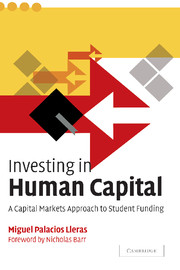Book contents
- Frontmatter
- Contents
- List of figures
- List of tables
- Foreword
- Acknowledgments
- Introduction
- Part I The problem of financing education
- 1 The value of education
- 2 Market failure in the financing of education
- 3 The need for alternatives to traditional funding
- Part II Equity-like investments to finance education
- Part III Implementing human capital contracts
- Appendix A Valuation of human capital contracts
- Appendix B Using human capital options to value income-contingent loans
- Appendix C Features of human capital contracts, income-contingent loans, and traditional mortgage-type loans
- Appendix D A developing country study
- Notes
- References
- Index
3 - The need for alternatives to traditional funding
Published online by Cambridge University Press: 08 January 2010
- Frontmatter
- Contents
- List of figures
- List of tables
- Foreword
- Acknowledgments
- Introduction
- Part I The problem of financing education
- 1 The value of education
- 2 Market failure in the financing of education
- 3 The need for alternatives to traditional funding
- Part II Equity-like investments to finance education
- Part III Implementing human capital contracts
- Appendix A Valuation of human capital contracts
- Appendix B Using human capital options to value income-contingent loans
- Appendix C Features of human capital contracts, income-contingent loans, and traditional mortgage-type loans
- Appendix D A developing country study
- Notes
- References
- Index
Summary
So far we have seen that there are opportunities for investing in education that generate attractive returns, and that those opportunities are hard to finance through the traditional lending methods. This chapter analyzes the ways in which higher education has been financed and why these solutions cannot cope with the increased demand that society will face in the future. Already, tuition fees have increased and there are growing worries on how to finance higher education costs.
Traditional funding
The traditional solution for funding higher education has been the direct financing and delivery by the state. A basic model of state finance can be represented by figure 3.1
Under this model, governments fund and manage higher-education institutions. Students receive free or nearly free education that in theory is available to all according to their academic merit. Many countries have followed this model. However, it has at least two problems: first, it can become inefficient; and, second, governments lack the resources to expand the system adequately.
A publicly financed and operated higher-education system can be inefficient because the consumers, i.e. students, cannot effectively influence the decisions of the public employees. The possibility of exerting this influence exists under the assumption that higher-education students behave like rational, well-informed consumers. Examples abound of poorly managed public institutions of higher education where the students' only option is not to attend.
- Type
- Chapter
- Information
- Investing in Human CapitalA Capital Markets Approach to Student Funding, pp. 30 - 38Publisher: Cambridge University PressPrint publication year: 2004



